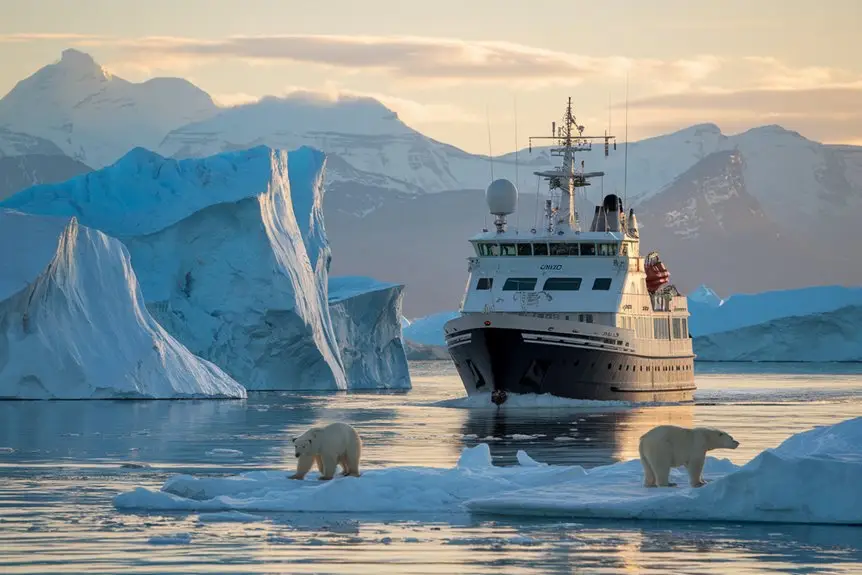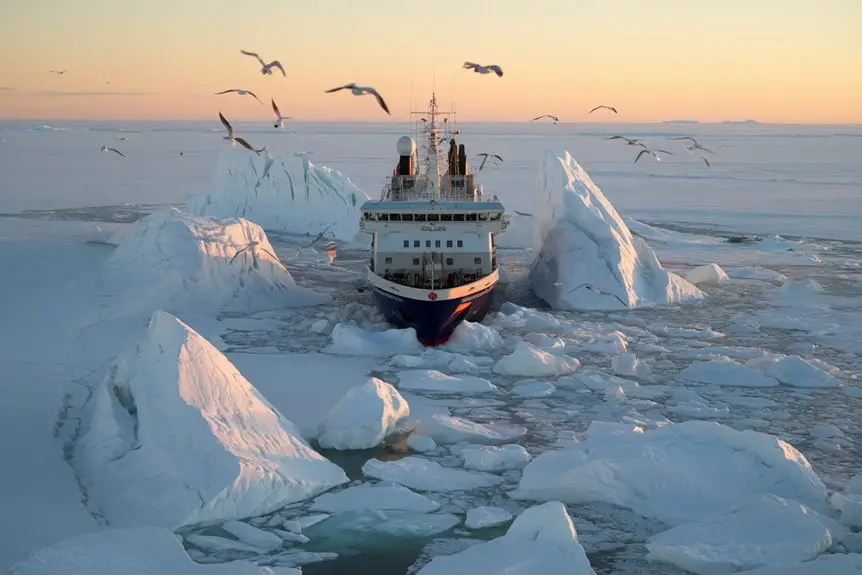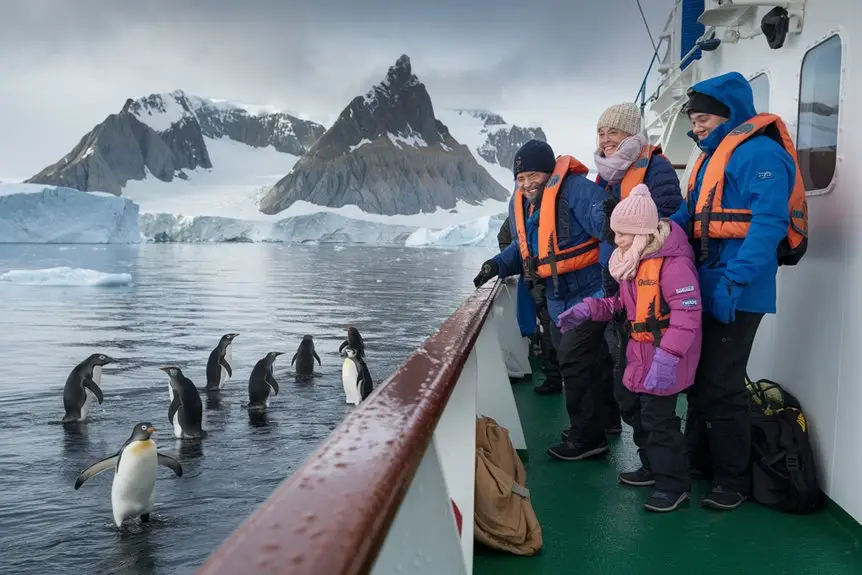When picking your polar expedition cruise, you’ll want to think about a few important things to get the perfect trip. First, work out whether you fancy Antarctica (November-March) or the Arctic (June-September), then pick your ship size – smaller boats mean more chances to go ashore, while bigger ships give you extra comfort.
Think about what sort of cruise suits you: posh ones with fancy facilities, activity-based trips for those who like getting stuck in, or science-focused journeys for learning about the regions. If you’re bringing children along, look out for ships with special programmes for youngsters and proper safety kit.
Let’s go through these choices properly to find the right polar trip for you.
🐧 Polar Cruise Enquiry 🐻❄️
Our team of polar travel specialists have personally explored both the Arctic and Antarctic regions – from tracking polar bears in Svalbard to kayaking with penguins off the Antarctic Peninsula. Let us find the right polar expedition cruise for you.
Key Takeaways
- Time your cruise right – head to Antarctica between November and March, or to the Arctic from June to September.
- Pick your ship size wisely: smaller vessels mean more chances to go ashore, whilst bigger ones give you extra comfort and better stability.
- Match the cruise type to what you fancy: posh expedition, activity-focused trips, or learning-based research voyages.
- Think about how long you need – at least 10 days for Antarctica, 7-14 days for Arctic areas.
- Consider which animals you’d like to see – Antarctica has penguins and whales, whilst the Arctic is home to polar bears.
Choosing Your Polar Cruise

If you’re thinking about going on a polar cruise, two main things matter most: where you want to go and when.
For Antarctica, you’ll want to travel between November and March – that’s when you’ll see the most wildlife and have better weather.
Up in the Arctic, June to September is the best time, with 24-hour daylight and the best chance of spotting polar bears.
Both places are brilliant but quite different.
In Antarctica, you’ll see massive icebergs, loads of penguins and whales swimming about.
The Arctic’s got polar bears, local communities and, if you go early or late in the season, you might catch the Northern Lights.
Think about how long you want to be away, too – Antarctic trips need at least 10 days because you’ve got to cross the Drake Passage, while Arctic journeys can be anywhere from 7 to 14 days, depending on where you’re headed.
Ship Size for Polar Cruises

Once you’ve chosen where and when to go, the size of your ship makes a big difference to your polar journey.
Smaller ships (50-120 passengers) can go through tighter channels and make more landings since Antarctic rules only let 100 people go ashore at once. You’ll get a more personal feel, and these ships usually manage more zodiac trips each day.
Bigger ships (200+ passengers) have more facilities, handle rough seas better, and tend to be cheaper. The downside is they can only sail in deeper water and need to take people ashore in shifts, meaning less time on land.
Mid-sized ships (120-200 passengers) strike a nice balance, giving decent access to landing spots whilst keeping things comfortable and steady.
Think about what matters most to you: if you want loads of time on shore, go smaller; if you prefer more comfort, choose a larger ship.
First-time expedition cruisers smart enough to Alaska expedition cruises with Lindblad National Geographic discover whether they actually like zodiac landings and expedition-style travel before dropping Antarctica money on the gamble.
Polar Cruise Ship Types

Different polar ships suit various exploration preferences and comfort needs.
You’ll come across traditional ice-strengthened expedition vessels that strike a good balance between comfort and exploration abilities, giving you a proper polar journey.
Luxury expedition ships come with posh amenities whilst keeping their polar capabilities, with fancy cabins and top-notch food.
Research ships turned tourist vessels feel more like genuine exploration craft, with basic facilities but brilliant access to scientific gear and observation spots.
Some specialist ice-breakers can smash through heavy pack ice to reach places other ships simply can’t get to.
Nuclear-powered ships work mainly in the Arctic, while purpose-built hybrid vessels use modern propulsion systems to minimise their impact on the environment.
Each type of ship has its own strong points, from better wildlife viewing areas to particular landing abilities.
Polar Cruise Style Options

Your polar cruise style choice really comes down to what you want to do and how comfy you need to be.
There are three main types: luxury expedition cruises, quest-focused expeditions, and research-oriented trips.
Luxury cruises have posh cabins, fancy food and still let you see wildlife and go ashore.
Quest expeditions are all about getting stuck in – lots of zodiac landings, hiking, kayaking, and even camping.
Research trips have actual scientists on board, loads of learning programmes, and you’ll visit research stations to learn about things like marine biology or glaciology.
Think about how active you want to be, what sort of comfort you need, and what interests you most.
If you’re keen on spending heaps of time ashore being active, go for quest-style.
If you’re mad about learning, pick research-focused.
Want comfort whilst exploring? The luxury expedition cruises are your best bet.
Family Polar Cruise Guide

While polar trips might seem like grown-up holidays, many cruise companies now run family-friendly voyages suitable for everyone.
You’ll find ships with adjoining cabins, children’s menus and special youth activities led by trained wildlife experts.
Keep an eye out for cruises with activities suited to different ages, like polar swimming certificates, wildlife photo lessons and young scientist programmes.
Many ships have special areas on deck where children can safely spot whales and seabirds. Some companies even plan trips during school holidays.
Before you book, find out the minimum age allowed, as this changes between companies.
Make sure there’s medical help onboard, and double-check the ship has proper safety kit that fits children.
Think about how long the cruise lasts too – shorter trips often suit families with little ones better.
Frequently Asked Questions
What Medical Facilities and Staff Are Available on Polar Expedition Ships?
As they say, it’s better to stop something bad happening than to fix it later. You’ll find a doctor and medical centre on board, equipped with essential emergency gear, medicines and kit to keep patients stable until you can get to proper medical care on the mainland.
Can I Use My Regular Mobile Phone During the Polar Cruise?
Your mobile won’t get normal signal in polar areas. You can use your phone on the ship through satellite internet, but it costs quite a bit. Best to download your maps and anything else you need whilst you’re still at home.
How Physically Fit Do I Need to Be for Polar Excursions?
Imagine trekking through the snow. You’ll want to be reasonably fit to cope with daily zodiac boat rides, walk 2-3 kilometres on rough ground, and handle stairs. Being able to move about easily is a must.
Are Polar Bears Dangerous During Shore Landings in the Arctic?
Yes, polar bears are incredibly dangerous. You’ll always have armed guides with you to keep your group safe. Don’t go wandering off by yourself, and make sure you listen to your expedition team’s safety rules properly.
What Emergency Evacuation Procedures Exist for Polar Expedition Cruises?
There’s helicopter support, rescue boats and medical help ready if needed. Your ship has satellite gear and keeps in touch with coastal rescue stations so they can act quickly if there’s trouble.
🐧 Polar Cruise Enquiry 🐻❄️
Our team of polar travel specialists have personally explored both the Arctic and Antarctic regions – from tracking polar bears in Svalbard to kayaking with penguins off the Antarctic Peninsula. Let us find the right polar expedition cruise for you.
